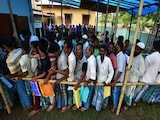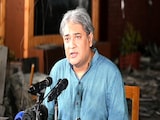The Supreme Court will begin day-to-day hearings on Madhya Pradesh's move to grant 27 per cent reservation for Other Backward Classes or OBCs. The hearings will begin on October 8. The court's decision comes amid a social media storm over the alleged inclusion of a 42-year-old report by a commission that cited mythology and history to justify safeguards for OBCs.
The state has denied these allegations, claimed it has merely cited the Ramji Mahajan Commission report - which runs to 1,265 pages - instead of including it in its affidavit to the top court.
The Ramji Mahajan Commission report was submitted to the then Congress government in 1983.
The Quota Battle
The state's decision to grant 27 per cent reservation to Other Backward Classes is a move that, with existing quotas, pushes the Supreme Court's cap far beyond 50 per cent.
Officials said the state has anchored its defence on "extraordinary circumstances" for breaching the 50 per cent ceiling.
The government said its 15,000-page affidavit includes surveys, commission findings and administrative data on under-representation of OBCs in services and public life in the state, where OBCs and tribals comprise almost 50 per cent of the population.
Battle Over Ramji Commission Report
Lately there have been claims on social media that the state relied on the Ramji Mahajan Commission report to argue that ancient social practices "broke the social order". The report had cited episodes from Mahabharat and Ramayan involving Shambook and Ekalavya to justify extra reservations for OBCs.
The social media claims - accompanied by unverified screenshots -- also say while the Mahajan panel recommended 35 per cent OBC quota in 1983, the state's decision was 27 per cent, showing it has not mechanically adopted the Commission's figure.
Officials say selective, out-of-context circulation of old material on social media is being investigated and "appropriate action" will follow.
How It Started
In 2019, the then Kamal Nath government passed a law upping OBC quota from 14 to 27 per cent. But the MP High Court stayed its implementation, reiterating the 50 per cent ceiling principle.
In September 2021, the BJP government permitted 27 per cent reservation for the OBCs.
In May 2022, a petition was filed in the Madhya Pradesh High Court, which stayed the implementation of the 27 per cent quota.
In August 2023, a 87:13 mechanism was announced under which results for 87 per cent of advertised posts could be declared and 13 per cent kept on hold pending decision on the OBC quota.
In 2024, all pending petitions regarding OBC reservation hike (around 70 in total) were transferred from the High Court to the Supreme Court. Till the final decision is made, recruitments are being made on basis of the 87:13 formula.
The State's Quota Break-Up And the Dilemma
MP's amended matrix took the total reservation to 73 per cent -- ST 20% + SC 16% + OBC 27% + EWS 10%.
The main question now is whether the state can justify crossing the 50 per cent quota cap by proving "extraordinary" under-representation with strong, contemporary data.
The state has often claimed that 48 per cent of MP's population comprises OBCs, but conceded it lacks a recent, formal headcount --- a gap that earlier contributed to stay orders from the High Court in 2019 and 2022.
13 Per Cent Undecided Seats The Key
Until the Supreme Court gives a verdict, the 87:13 formula remains in place.
Of the 13 per cent posts kept on hold, half the seats are notionally for OBCs and half for the general category. So whichever way the court rules, final allocation can be adjusted without cancelling entire recruitments.
Why The Urgency
Since 2019, 35-plus recruitments have been interrupted. Around 8 lakh aspirants have faced uncertainty, 3.2 lakh selected candidates await joining orders. Since the 2023 assembly polls, the state says it has filled 29,000 posts, but 1,04,000 vacancies still remain.
From October 8, the top court's daily scrutiny will test if Madhya Pradesh has evidence strong enough to cross a constitutional Rubicon and, just as crucially, whether lakhs of stalled appointments can finally move from lists to letters.















